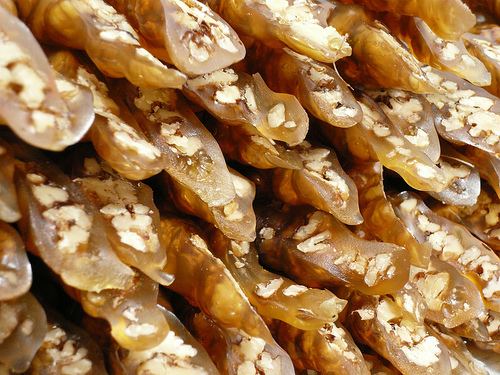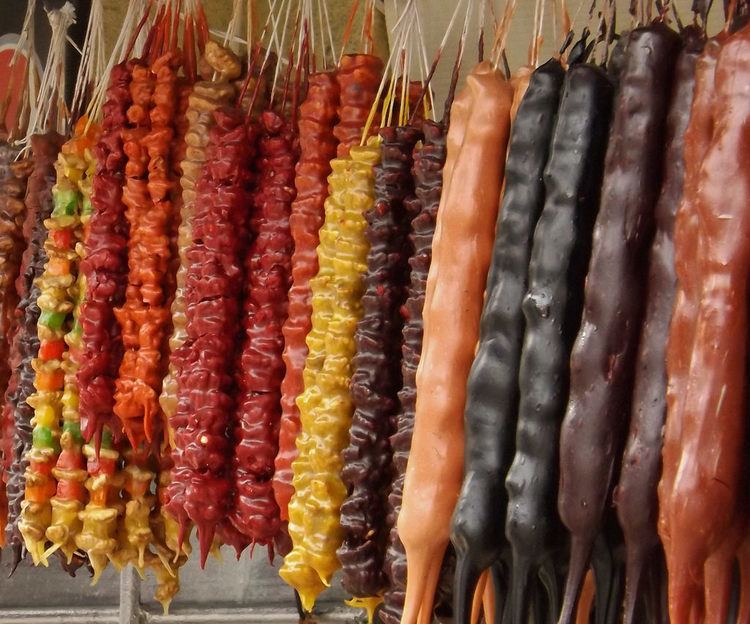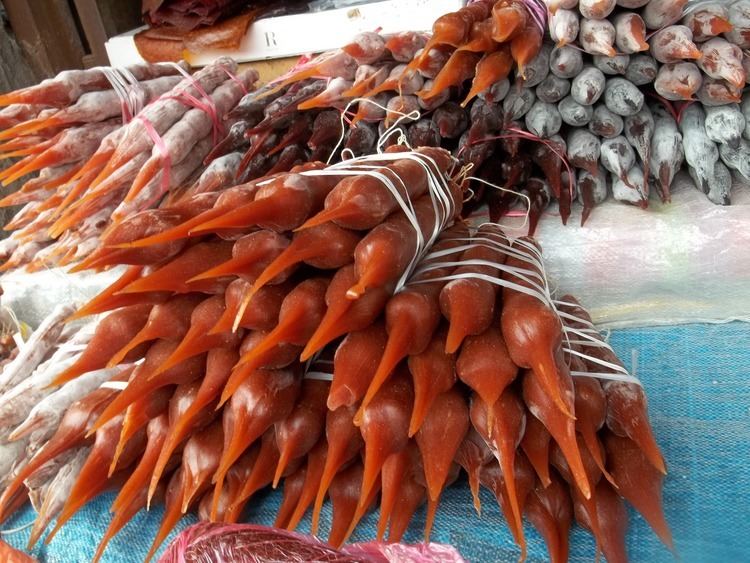 | ||
Similar | ||
Making churchkhela part 1
Churchkhela (Georgian: ჩურჩხელა, [tʃʰurtʃʰxɛlɑ]) is a traditional Georgian candle-shaped candy. The main ingredients are grape must, nuts and flour. Almonds, walnuts, hazel nuts and sometimes raisins are threaded onto a string, dipped in thickened grape juice or fruit juices and dried in the shape of a sausage.
Contents
Churchkhela georgian candy
Outside Georgia

Churchkhela and its varieties are popular in several countries besides Georgia, such as Iran, Armenia, Azerbaijan, Cyprus, Greece, Russia, Ukraine, and Turkey. In Persian, it's known as "Lævascæck Adjili" (لواشک آجیلی)[]. In Armenian, Greek, and Turkish it is known as "sujuk", which is actually a dry sausage. To distinguish the two, it is sometimes referred to as "sweet sujukh" (քաղցր սուջուխ, kaghtsr sujukh) in Armenian and cevizli sucuk ("walnut sujuk") in Turkish. It is known in Cypriot Greek as soutzoukos (σουτζούκος or σουτζιούκκος) and as soutzouki (σουτζούκι) in Greece. The Cypriot variety is made by dipping strings of almonds into jelly, called palouzes or moustalevria.
Preparation

Churchkhela is a homemade Georgian product. Georgians usually make Churchkhela in Autumn when the primary ingredients, grapes and nuts, are harvested. It is a string of walnut halves that have been dipped in grape juice called Tatara or Phelamushi (grape juice thickened with flour), and dried in the sun. No sugar is added to make real Churchkhela. Instead of walnuts, sometimes nuts or almonds are used in the regions of west Georgia. The shape of Churchkhela looks like a candle, but some people say it looks like a sausage. Georgian warriors carried Churchkhelas with them because they contain many calories. The best Churchkhela is made in Kakheti region, which is renowned as the motherland of wine.

The juice is placed in a large bronze cauldron (called chartzin or kazani) and heated slowly. A small amount of a special white earth called asproi is added to the boiling must and causes impurities to rise to the surface, where they are collected and removed. It is possible to substitute asproi, when not available, with lager beer, which has a similar result. Once the cleansing process is complete, the liquid is left to cool. Next, flour is added while stirring and heating the mixture. When it reaches the right consistency, based on the rate of steam bubbles and the viscosity of the mixture, it is removed from the heat. The mix, called palouzes, is now ready for use in the next step in the process of making soutzoukos, which consists of preparing the nuts for dipping.

Before they are threaded, the nuts have to be shelled and dipped into water in order to soften them. Once soft enough, they are strung onto 2-3 meter-long threads. The strings are dipped in the palouzes mixture until completely covered. This process is repeated several times (usually three times) until the soutzoukos has the desired thickness. Soutzoukos strings are then left to dry for 5–6 days. They are then ready for consumption or storage, even though some people like to eat soutzoukos fresh.
Consumption
Churchkhela is a snack for in-between and is also served as a dessert during the New Year and Christmas celebrations.
